|
GUILIN (Day 13 - part 1)
Our first stop of the day was the Reed Flute Cave with its colorful light and laser show.
Guilin was first established in 314 BC as a small settlement along the banks of the Li River. Its present-day name, which it received in 1940, means Forest of Sweet Olive (or Sweet Osmanthus), owing to the large number of these fragrant trees located in the city.

Guilin
Reed Flute Cave (Ludi Yan) got its name from a type of reed growing outside, which can be made into melodious flutes. Tourists began to visit here in the Tang Dynasty, although it wasn't officially opened to the public until 1962. Today this water-carved cavern is illuminated by colored lights which make it a fascinating gallery of limestone formations, hence giving it its nickname of The Palace of Natural Arts.
Reed Flute Cave lies at the southern slope of Brightness Hill. 400 million years ago, this area was under an ocean. After several earthquakes, the water eventually receded. The cave came into shape about 600,000 years ago.
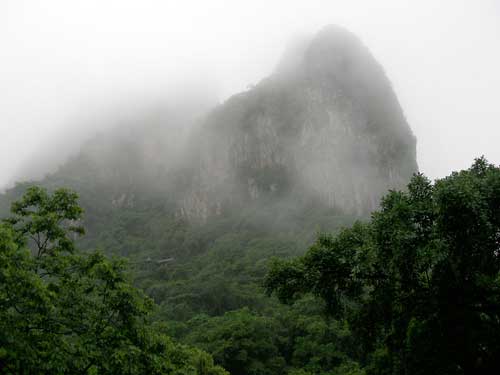
Misty mountains surround the area.
Many of the formations are given fanciful names such as Pines in the Snow, Mushroom Hill, Flower Mountain, or Morning Glow over Lion Forest. Along with the surreal lighting, flute music and bird sounds were piped into many parts of the cave to create an other-worldly effect. In many ways, it felt more like an artificial amusement park rather than a structure of natural beauty.
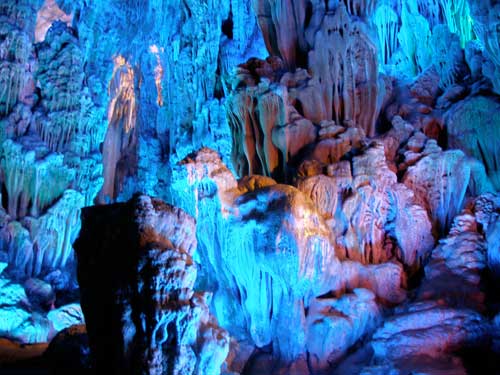

Crystal Waterfall
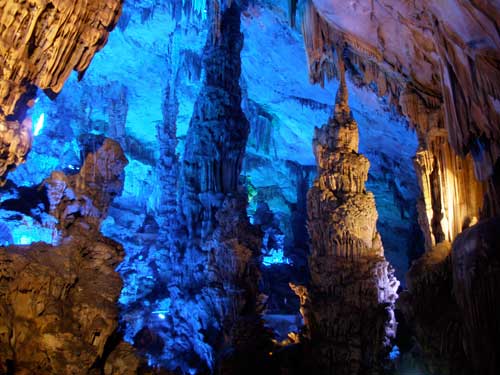
Dragon Pagoda (right)
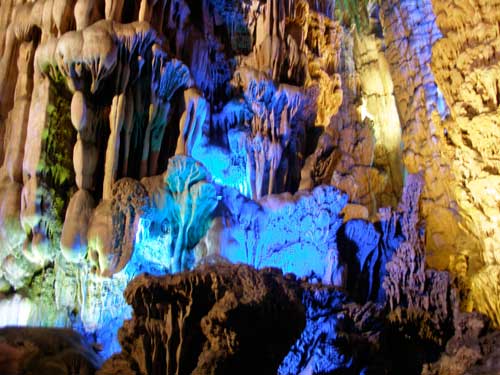
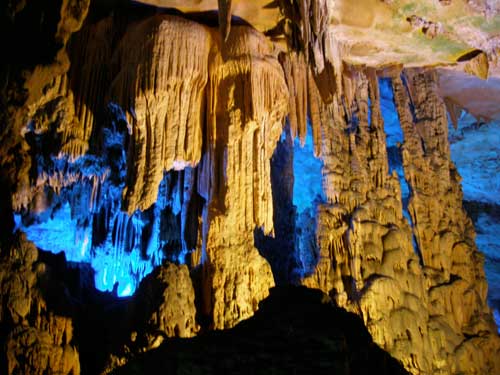
A stalactite (from the Greek meaning "drip") is a type of cave formation that hangs down from the ceiling of a limestone cave due to the dripping of mineral-laden water. When the drop falls, it leaves behind the thinnest ring of calcite, which over times builds upon itself. The corresponding formation that rises up from the floor is known as a stalagmite. If these formations grow together, the result is a column.
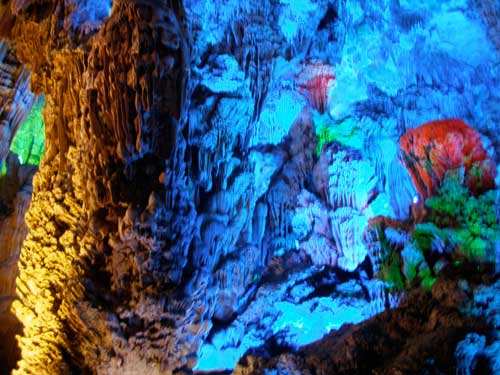
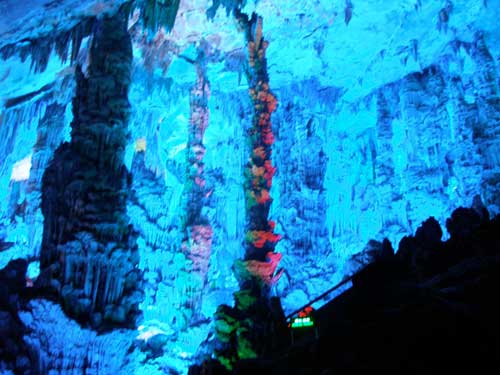
Primeval Forest
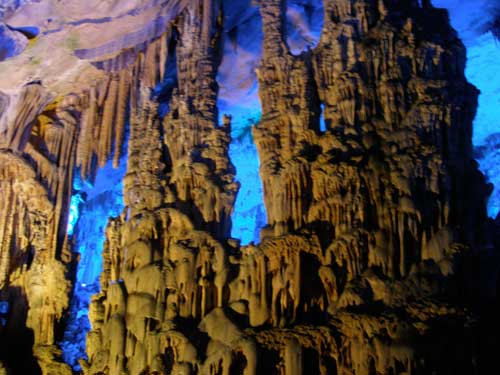
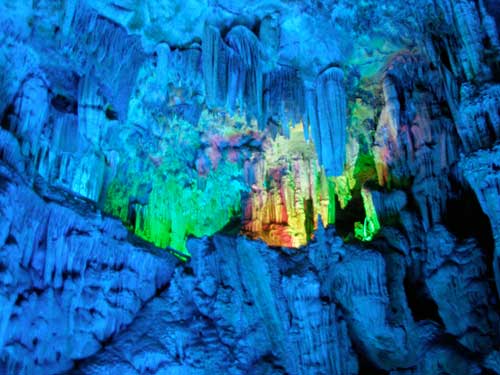
Crystal Palace of the Dragon King (Shuijing Gong) is the highlight of the cave, with a dense collection of limestone mounds reflected in the lake that carved it. This grotto is was also used as an air-raid shelter during World War II.

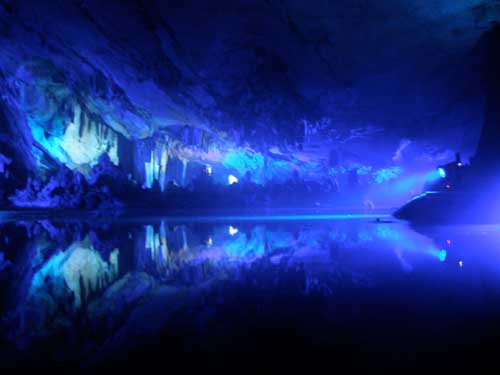
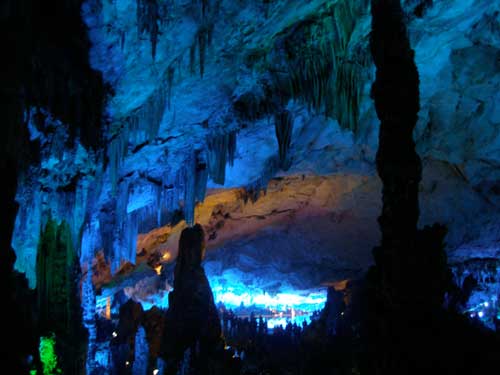
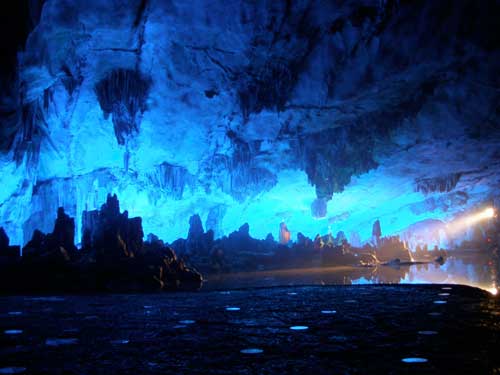
Lights embedded in the ground enable this part of the cave to serve as a dance floor.
Once we had all gathered in the room, lasers, music, colored lights and numerous bubble machines began to flood the senses in a final grand performance.
Next we visited Solitary Beauty Peak (Duxiu Feng). The mountain rises abruptly from the ground to a height of 217 feet. During the Southern Dynasty (420 - 589), Yan Yanzhi, governor of Guilin, wrote "None can surpass this solitary peak in beauty" and it is been called so ever since.
The peak stands in the garden an old walled city known as the Jingjiang Princes' City.
From 1368 - 1398, Emperor Taizu (aka the Hongwu Emperor) of the Ming Dynasty ruled China. Since the empire had become very large, the emperor, in order to further consolidate his rule, delegated various principalities to his 24 grandsons, whose offspring in turn would rule them, and who would be referred to as princes or kings (since a Ming Dynasty emperor ruled for a long period of time, he was generally not succeeded by a son but by a grandson, and therefore it was these who needed to be appeased).
The first such prince of the Guilin area, King Jingjiang (aka Zhu Shouqian), was thus the founding father of a mini-dynasty that ruled the principality in succession. He had a palace built in 1372, with Solitary Beauty Peak towering above it. Since then, 14 Jingjiang kings or princes have lived in this city with their families. Later during the Qing Dynasty, the city compound was turned into a provincial examination center. Today, it is the grounds of the Guangxi Province Normal University.
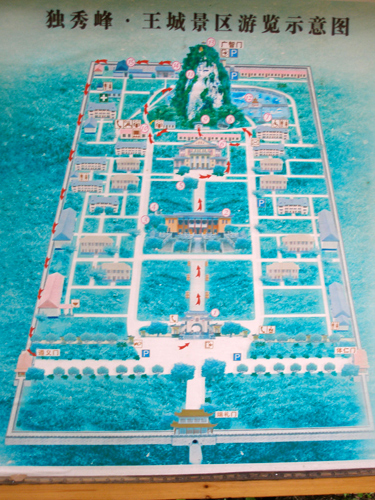
A map of the Jingjiang Princes' City
King Jingjiang's palace was laid out as a city, conforming to the strict plans for royal palaces set down by his grandfather, Emperor Taizu. All such palatial constuctions were modelled after the not-yet-constructed (but planned) Forbidden City (which would be built by the emperor's son, the Yongle Emperor, in 1406).
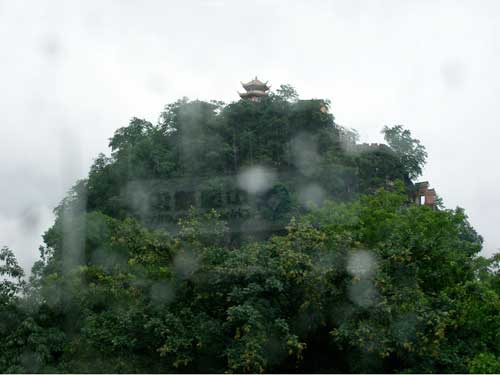
The limestone peak has been called the Pillar of the Southern Sky.
Huang, our local guide, gave us an informative tour at the foot of the peak.
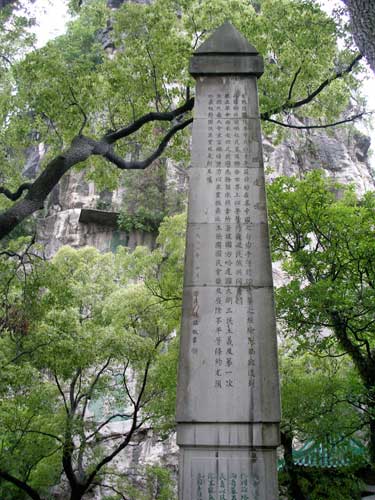
This pillar was built 1921 to honor Dr. Sun Yat-sen (1866 - 1925), the leader of the new republic, who once used this palace complex for his regional headquarters. As the foremost pioneer of a Republican China, Sun is frequently referred to as the Father of the Nation. He played an instrumental role in overthrowing the Qing Dynasty in 1911, the last imperial dynasty of China.
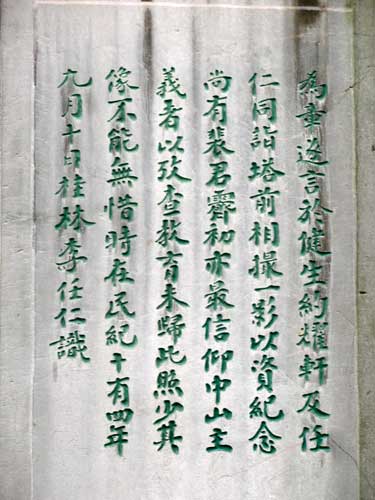
The inscription on the pillar
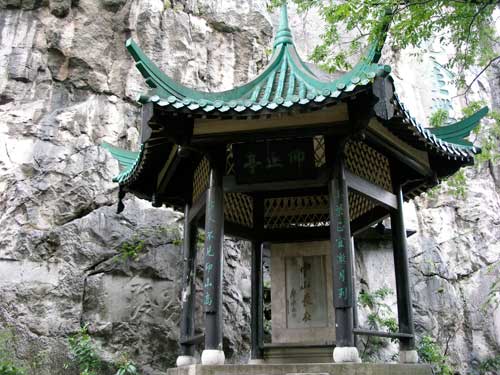
A small pagoda
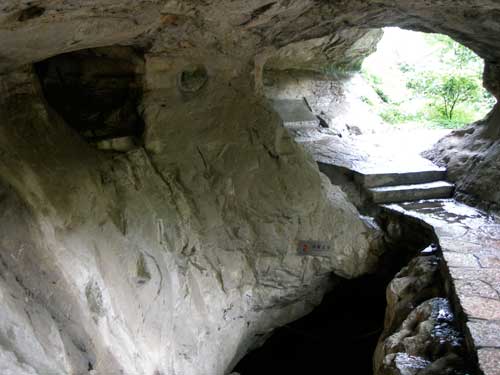
There are many peculiar caves in this area. The most famous one is Study Rock (Dushu), which looks like a stone room with natural windows and beds inside. Engraved here more than 800 years ago is Yan Yanzhi's famous line naming Solitary Beauty Peak.
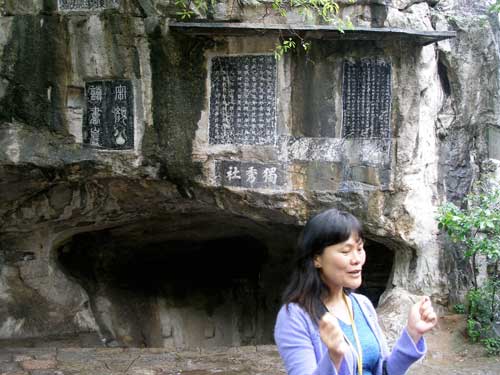
Huang in front of Study Rock
Huang (pronounced Hwong) is a member of the Zhuang ethnic minority. The Zhuang are one of China's 56 ethnic groups, and with a population of 15 million, they are second only to the Han people, who account for more than 91% of the nation's total population. The term was first recorded some 1,000 years ago in the Song Dynasty, but the Zhuangs used to call themselves by at least a dozen other names too. The group's ancient culture and art is rich and colorful. Frescoes over 2,000 years old have been found on the precipices overhanging the Zuojiang River, which runs through southwest Guangxi, the province we are now in.

In the old days, everything used to be carved in stone.
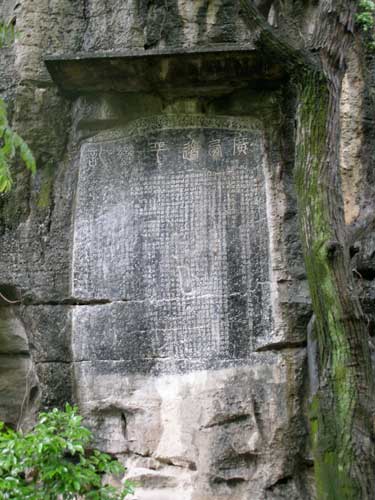
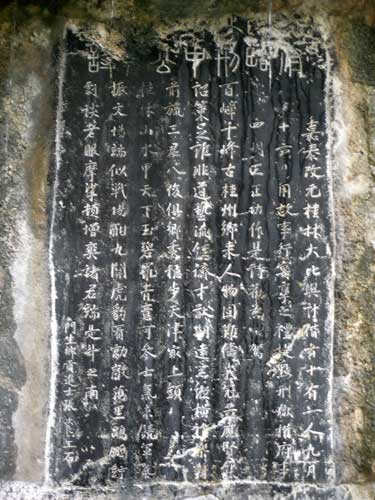

A few of us then opted to pay the price of 306 steep stone stairs to the top... with the reward is a panoramic view of the whole city and surrounding mountains.
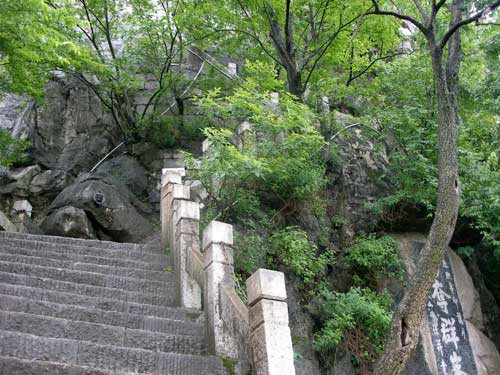
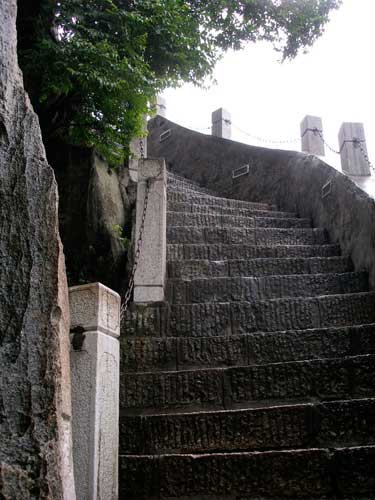
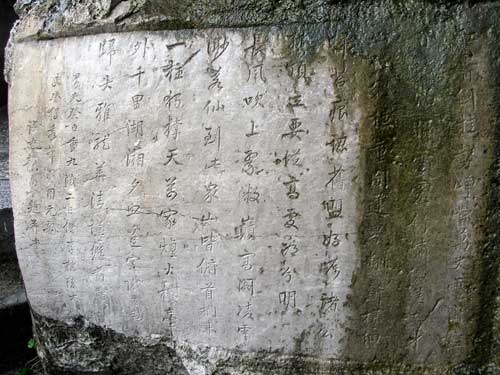
Carvings of all shapes and sizes cover the mountainside.
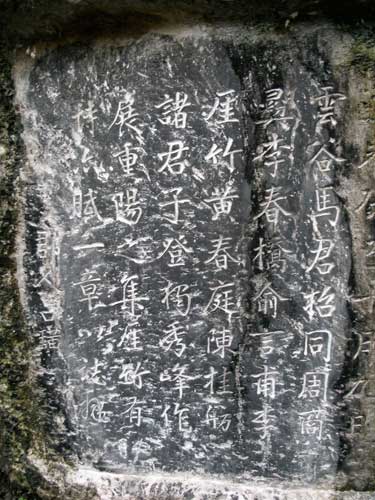
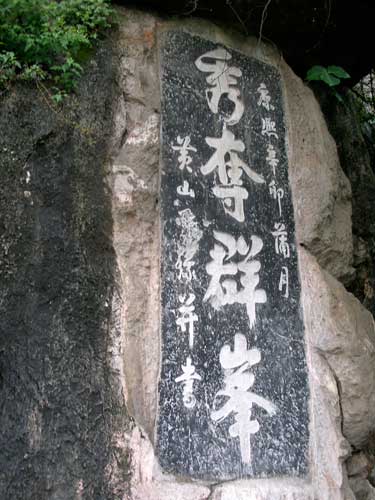
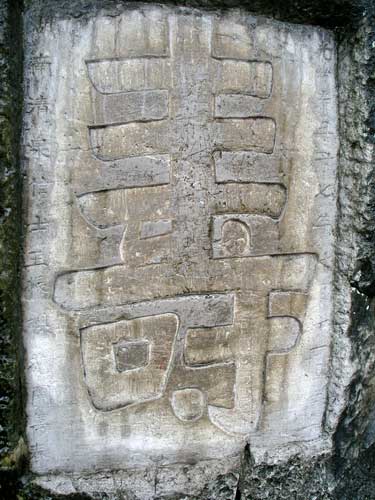
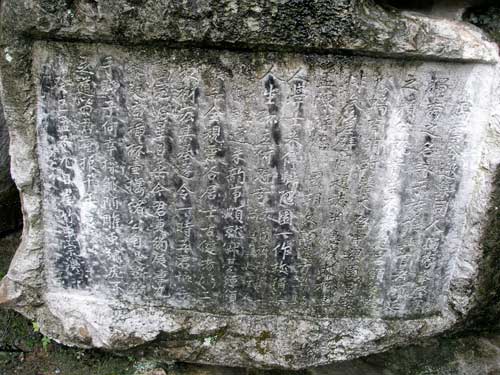

Xuanwu Pavillion was first built during the Ming Dynasty. The past Jingjiang princes went here to ask for favorable weather for crops, permanent kingship and long lives. It was strictly off-limits for non-royalty, although a few politicians or literary masters were lucky enough to be allowed up here in the past.
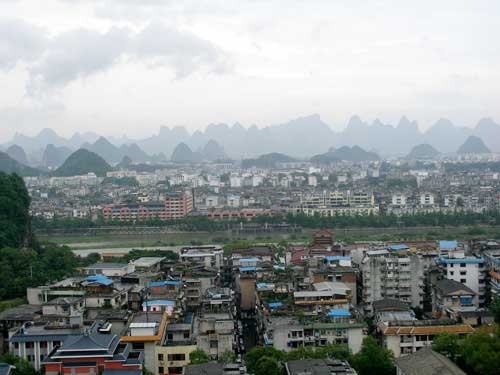
A view of the city, Li River and panoramic mountains

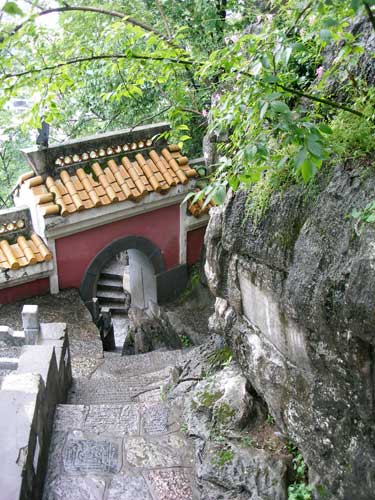
Heading back down the steep path

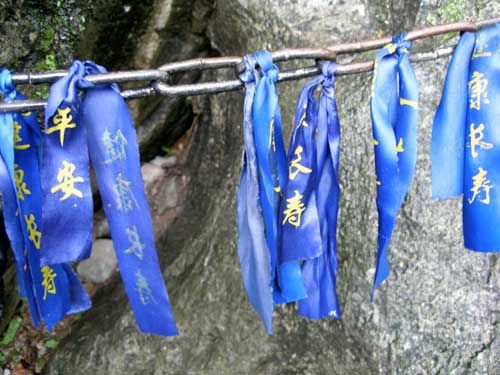
Small flags line the way.
|
|

